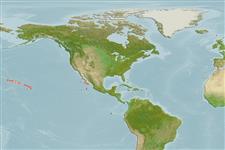Environment: milieu / climate zone / depth range / distribution range
Ecología
marino batidemersal; rango de profundidad 786 - 872 m (Ref. 40826). Deep-water
Distribución
Países | Áreas FAO | Ecosistemas | Ocurrencias, apariciones | Point map | Introducciones | Faunafri
Eastern Central Pacific: Hawaiian Islands.
Tamaño / Peso / Age
Maturity: Lm ? range ? - ? cm
Max length : 13.6 cm SL macho / no sexado; (Ref. 40826)
Radios blandos dorsales (total) : 6 - 7; Vértebra: 18. Unique tubercles multi-spined, clustered in center of each tubercle. No large rostral spine, nor long simple spines on dorsal surface of disc. Tubercles along sides of tail each with 2-4 long, irregularly sized, somewhat flaring spines. Toothed scutes on tubercles absent. (Ref. 40826).
Life cycle and mating behavior
Maturities | Reproducción | Spawnings | Egg(s) | Fecundities | Larva
Bradbury, M.G., 1999. A review of the fish genus Dibranchus with descriptions of new species and a new genus, Solocisquama (Lophiiformes, Ogcocephalidae). Proc. Calif. Acad. Sci. 51(5):259-310. (Ref. 40826)
IUCN Red List Status (Ref. 130435)
Threat to humans
Harmless
Human uses
Herramientas
Special reports
Download XML
Fuentes de Internet
Estimates based on models
Phylogenetic diversity index (Ref.
82804): PD
50 = 0.6250 [Uniqueness, from 0.5 = low to 2.0 = high].
Bayesian length-weight: a=0.02291 (0.00925 - 0.05675), b=2.94 (2.72 - 3.16), in cm total length, based on LWR estimates for this (Sub)family-body shape (Ref.
93245).
Nivel trófico (Ref.
69278): 3.3 ±0.6 se; based on size and trophs of closest relatives
Resiliencia (Ref.
120179): Medio, población duplicada en un tiempo mínimo de 1.4-4.4 años (Preliminary K or Fecundity.).
Fishing Vulnerability (Ref.
59153): Low vulnerability (10 of 100).
